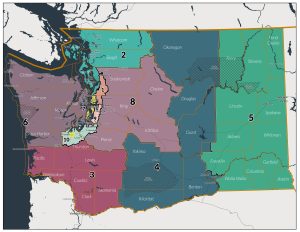Module 6 Congress and the Presidency
In this chapter:
Overview of Module 6
Classroom Lessons and Activities
Discussion 6.1 Congressional Redistricting and Gerrymandering
Discussion 6.2 Presidential Power – The Unitary Executive Theory
Additional Resources
Overview
Module 6 for the sixth week of the course includes the following page giving an overview of the Module’s content and the week’s activities:
Module 6 – Congress and the Presidency
[insert images: 1) Trump speech on Jan 6; Capitol riot scene Jan 6; Capitol riot scene Jan 6 – #2]
VIOLENT ATTACK ON CONGRESS. In January 2021, then President Trump was charged (impeached) by the House of Representatives for inciting insurrection in connection with the rioters who stormed the Capitol building on January 6, resulting in five deaths. The violent break-in at the Capitol building, which houses Congress, was the first major assault on the building since the British burned it down in the War of 1812. The attackers this time were Americans – Trump supporters – trying to disrupt Congress from fulfilling one of its Constitutional duties: counting the Electoral College votes for the 2020 presidential election sent to it by the 50 states. The “disruption” was successful, but only temporarily – after evacuating Members from the House chamber for safety, they later returned and finished counting the votes. The U.S. Senate ultimately acquitted Trump on the impeachment charges, as they did in his first impeachment trial a year earlier on other charges. The new (Democratic-controlled) Congress in 2021 formed a bi-partisan committee to investigate the insurrection to identify its leaders, planning and operations so that it could take action to help prevent something like this from happening again. As of January 31, 2022, 768 people had been charged with crimes related to the insurrection – but none of them (so far) has been alleged to have had direct connections to members in Congress or the White House.
PRESIDENTIAL OBSTRUCTION OF CONGRESS. One of the Articles of Impeachment in his first trial in 2020 charged Trump with “obstruction of Congress”, meaning he was not complying with requests by the House of Representatives to produce witnesses and documents related to his dealings with the government of Ukraine over military assistance in exchange for an investigation into one of his likely political opponents, former Vice-President (under Obama) Joe Biden (now President Biden). While a number of key Trump administration personnel defied Trump’s orders anyway and testified before Congress, many other potential witnesses did not. Congress was also denied access to official government files that may have shed light on the extent of the President’s alleged involvement in the Ukraine controversy. Pursuant to its constitutional impeachment powers, and by virtue of its constitutional role in oversight of the Executive branch (checks and balances), Congress believed it had a right to this information and needed it to discharge its duties. But President Trump refused to allow any witnesses to testify or turn over any documents requested.
Since leaving office, Trump tried to prevent the National Archives from turning over to the January 6 committee documents from the White House that may shed light on the former President’s actions before, during and after the insurrection. A court rejected his attempt (as an ex-President he no longer has a claim to executive privilege for those documents) and over 700 pages of documents were given to the committee. (The Committee concluded its work and published a report before the end of the last – 117th – session of Congress, as Republicans took control of the House on January 7, 2023 to begin the 2-year 118th session of Congress.)
EXECUTIVE PRIVILEGE. Past presidents have also wrestled with Congress over what information they would release to Congress, usually under a claim of Executive Privilege. Executive privilege has long been upheld by courts as a right of the President to refuse to disclose information provided to him by his closest advisors, in order to ensure advisors feel free to share important information without fear that it may later be revealed. But the defense of Executive Privilege is a limited one, usually raised on a case by case basis, with the President expected to justify why particular information at a particular time should not be disclosed. But President Trump never raised Executive Privilege as a basis for his refusal. Instead he simply refused to release any and all information.
UNITARY EXECUTIVE THEORY. Trump frequently asserted an interpretation of his constitutional powers as President known as the theory of the Unitary Executive. This controversial theory, which has been advocated by other presidents, asserts that the President is given by Article II of the Constitution exclusive powers that are not subject to Congressional review. After his acquittal in the first impeachment trial, Trump proceeded to fire or reassign personnel who testified against him or reached conclusions about the impeachment investigations that he disagreed with. And in his statements about who has the authority to “re-open” the economy in the midst of the Covid-19 pandemic, he asserted that he, not the governors of individual states who restricted activity, had total authority.
UNCHECKED POWER? The question all of this raises is whether this was the Framer’s intent in establishing the Article II Executive powers and the system of checks and balances, or if Trump simply used it as an excuse to amass more and more power unchecked by Congress. And if the latter, is there anything under the Constitution’s framework that could stop or limit him or another president seeking similar powers? As you study Chapters 12 (Congress) and 13 (The Presidency), keep these questions in mind and see what conclusions you reach on your own.
Classroom Lessons and Activities
Additional Resources
Other resources and documents used in class for this Module, including PowerPoint lecture slides, are in the Appendix.


